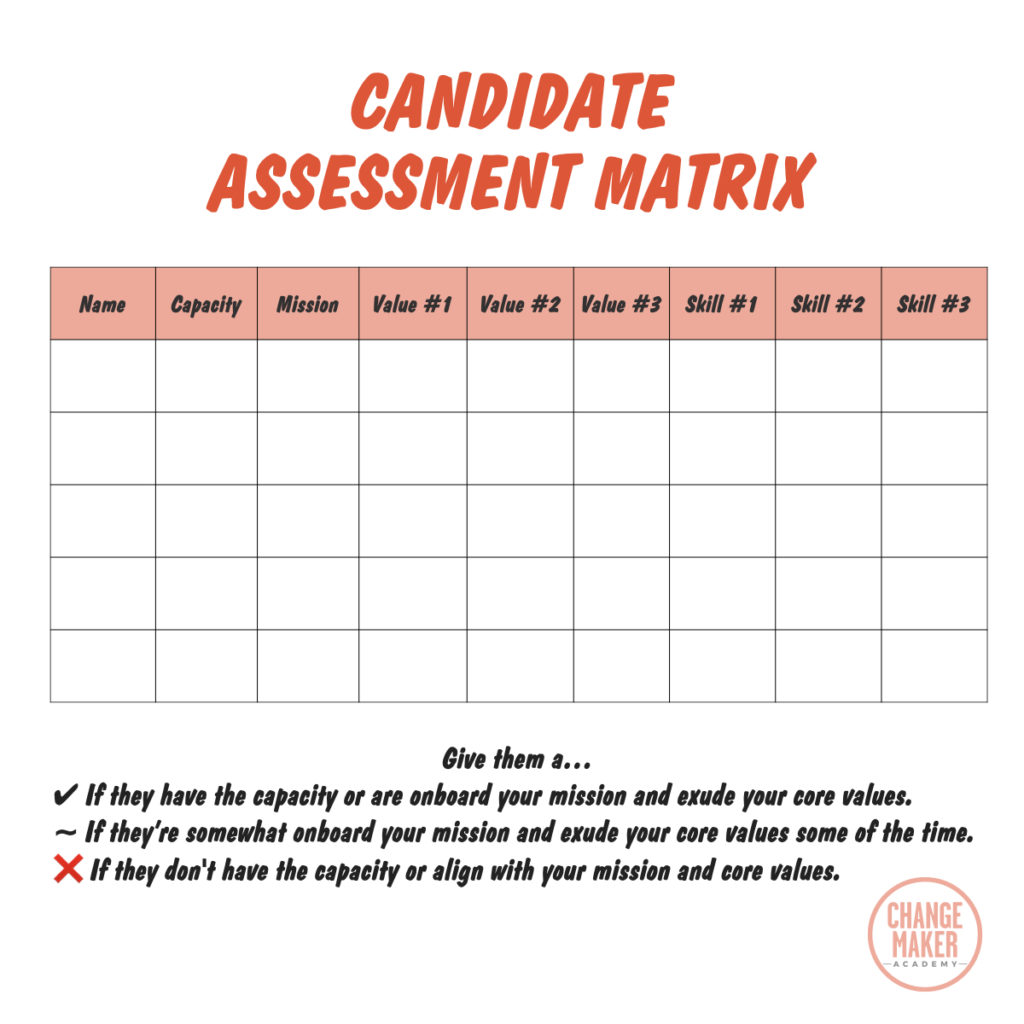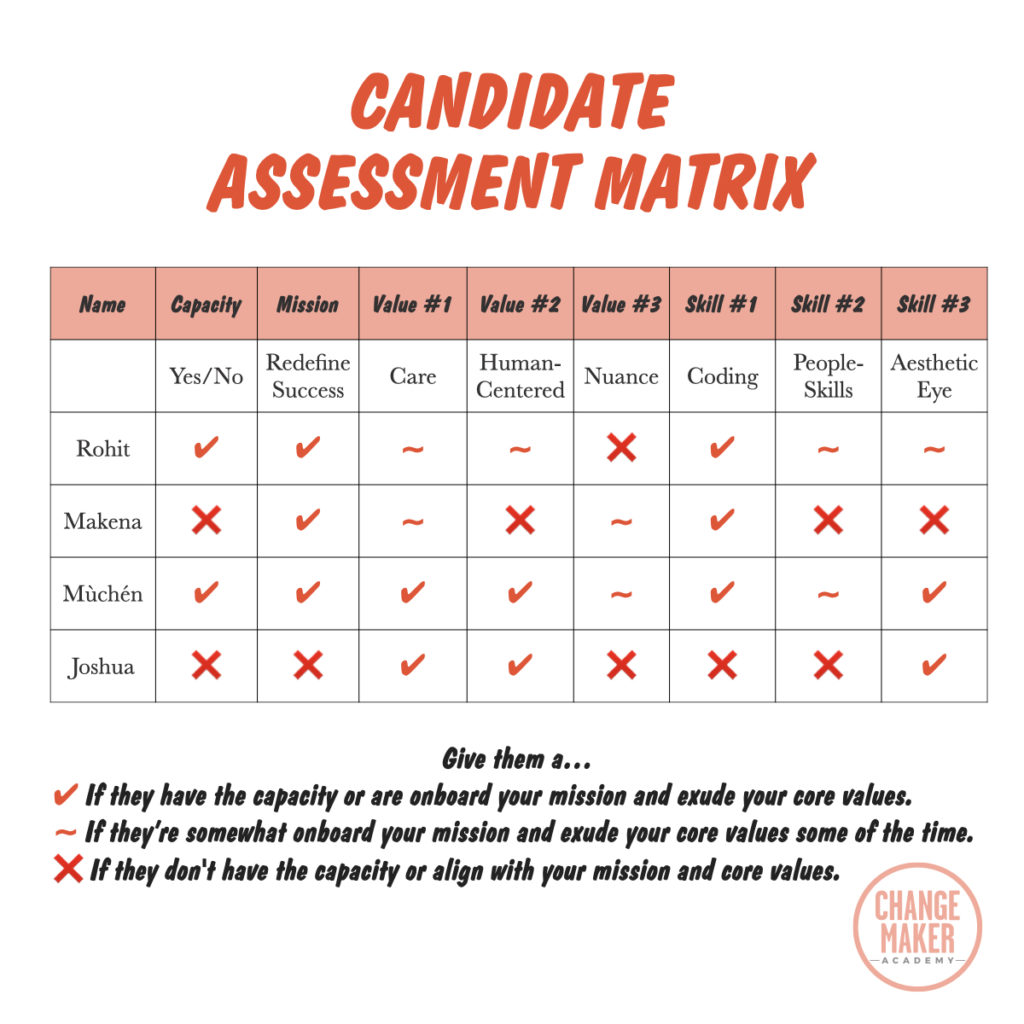Hiring The Wrong Person Can Destroy Your Organization: A Step-By-Step Guide To Finding Your “Can’t Lose” Candidate
++
As the common adage goes, if you want to build a great business, surround yourself with great people. But what does it mean to have “great people,” “A-players,” or “superstars” in your corner? In this article, we’re going to define this – explicitly – and show you how to attract the right people to rally behind your cause.
++
Talented and lazy
Back in college, I played with some extremely talented soccer players. One, in particular, had tremendous ball control. We’ll call her Sara.
If Sara had the ball anywhere near the 18 yard box, chances were high that she’d put it in the back of the net.
The only problem?
She was lazy. She needed expected the perfect pass, perfectly at her feet. And if she didn’t get it, she’d throw her hands up in the air in frustration as if it was anyone’s fault but her own.
Getting help on defense?
Good luck with that.

High individual performance, low team performance
There was no doubt that Sara was a force to be reckoned with. She scored goals and helped win games.
But her lack of work ethic – paired with her silver-spoon attitude – often negatively impacted team morale and the performance of the other ten players.
When she wasn’t on the field, the team was more positive. We worked together. We weren’t nervous about making the perfect pass, because we trusted one another to put in the effort to get to the ball, or work hard to win it back.
While individual stats weren’t as high as Sara’s, the team stats were higher without her there.

Sound familiar?
Chances are high that you’ve had experience working with someone like Sara. Someone who was talented at their job, yet didn’t jive with the rest of the team. Someone who performed well as an individual, yet brought down the performance of everyone else.
One of the most important decisions you can make…
Who you hire is one of the most important decisions you can make. According to the U.S. Department of Labor, the average cost of a bad hire is 30% of the employee’s annual salary. That said, for higher-level employees, it can cost up to 3.5 times their annual salary.
These costs include things like…
Recruiting efforts
Pursuing, interviewing, and screening candidates is a lengthy process. For executive-level positions, the average time to hire is 15 weeks, while a mid-management job is 9 weeks. Hiring new team members distracts your team from its core focus and can spread resources thin, especially in small organizations that cannot afford their own Human Resources department.
Onboarding expenses
It costs time and money to bring a new employee up to speed. Before they can take tasks off your plate, they’re going to have to learn your organization’s culture, way of working, and processes. To do this, you – or your employees – are going to have to take time out of the day to teach them. It can take 90 days for a new hire to become fully integrated into their new position. Even the best candidate is going to slow you down before they speed you up.
Benefits and health care costs
Incentives aren’t cheap. When you part ways with a bad hire, you may also be required to pay severance, which can make your decision even more regrettable.
Loss of productivity
Like Sara negatively impacted my soccer team, a bad hire can wreak havoc on even the most high-functioning organization. Your best employees are often the ones that will suffer the most, as they’ll pick up the slack, reduce their efficiency, and become dissatisfied. If left unchecked, you risk losing your best people due to someone you should’ve never hired in the first place.
Damaged reputation
If an employee isn’t doing their job well, your customers may suffer the consequences. This will make it harder to attract new customers, and you risk losing your current customers (which are often 5-10x more valuable).
… and more.
Not to mention, depending on where you work (physical office space or remotely), chances are high that you’ll spend more of your waking hours with your colleagues than you will your own friends and loved ones.

What to look for in a great hire
Before you can avoid a bad hire, you must get clear about what a great hire looks like.
From our perspective, there are three main criteria to consider when thinking about who to hire (and who to fire):
Hiring Criteria #1:
Cultural Fit
When the right people are working in your organization, they get what you do and what you’re about. They share your company’s values, they understand your mission, and they want to be a part of it. You enjoy being around them and the company is better with them in it.
Hiring Criteria #2:
Role Fit
While it’s great to like the people you work with, it can’t be the only criteria. Ideally, you’ll also hire people for the skills they possess, knowing that they’ll be able to carry out their role better than you could. The goal is to create a team that has complimentary skills, rather than redundant skills, based on their unique abilities and what is required for the role.
Hiring Criteria #3:
Capacity
It doesn’t matter if you find someone who wants to rally behind your cause and who has the skills to do the job well, if they don’t have the capacity to carry it out. The mental, physical, and emotional bandwidth has to be there, to the degree that it’s required. Some positions require 35 hours a week, and others require 55. Be clear about your expectations and ensure they can be met – within reason – upfront.

Four people problems health & fitness organizations face
It takes time to get the hiring process right. When you’re resource constrained, it’s tempting to hire too quickly (and make a wrong choice).
To save you from some of our downfalls,
Hiring Problem #1:
Right team, right role, insufficient capacity
Again, if someone doesn’t have the capacity to carry out the job, the choice is simple: you shouldn’t hire them. No matter how great of fit they are for your organization – or how awesome they are at their work – if they don’t have the bandwidth to do it, it’s a waste of everyone’s time.
Hiring Problem #2:
Right role, right capacity, wrong team
These are folks like Sara. They’re great at their job and they have the time to do it well. However, they don’t fit the culture. They don’t share your company’s values and they’re not onboard with your mission. Despite having domain-specific expertise, they bring you – and other colleagues – down.
Hiring Problem #3:
Right team, right capacity, wrong role
These folks fit your culture and they’re eager to be there. They put in the work, yet, the role that you’ve assigned them doesn’t let them shine. They’re not spending enough time (e.g. 80%) in their unique abilities, so everything they do is an uphill battle. Even when they work hard – and want to improve in the role – it’s exhausting and they underperform. This often happens when you’re so eager to work with people who “get” you and you like, that you don’t consider the skills that are actually required for the job. And oftentimes, the hire has redundant, rather than complementary skills, to your own. We also call this the “I just want to work with my friends” problem. 🙂
Hiring Problem #4:
Wrong team, wrong role, insufficient capacity
In this scenario, the person doesn’t fit your culture, they don’t have the skills to do it well, and they don’t have the physical, mental, or emotional bandwidth to even try. This hiring problem is also known as, “What the hell was I thinking?” problem. 😉 Thankfully, this problem is a lot more rare, as it’s hard for someone to stump you on all three accounts.

Now that you know what to avoid, how do you attract the right people?
Step 1:
Explicitly Define Your Organization’s Purpose
Work with your team members to explicitly define your company’s purpose, or the belief or mission that motivates you. Until you can clearly state what you are – and aren’t about – you won’t be able to share it with others, and you won’t be able to rally top talent behind your cause.
(You can find a step-by-step guide to finding your purpose here).
Step 3:
Define – And Aggregate – Your Team’s Superpowers
Clearly stating your own unique abilities is critical. It will help you figure out where you should focus (so you can generate the greatest amount of value, while having the most amount of fun), and it will show you how to best leverage the strengths of those on your team. Knowing what resources you already have, will help you discover what you need.
Alternatively, gathering your team’s unique abilities may also show you what you don’t need. If you have too many people who exude the exact same skills and you require work to be done in another domain (and your budget is tight), you may have to do the tough thing and let someone go.
(We show you exactly how to discover your own superpowers, and those of your team, here.)
Step 4:
Figure Out The Biggest Roadblock That Is Getting Between You And Your Goals
Set aside time (with your leadership team, if you have one) to think about your biggest goal over the upcoming year. Next, think about what is getting in the way of achieving it. You might discover that there are particular tasks that you’re not great at, or domain-specific expertise that you’re lacking. While you might be able to find a mentor – or a short-term contractor – to help you overcome your obstacles, if you’re maxed out in terms of capacity and this is outside the unique abilities of the members on your team, this could be a good sign of something you need to hire for.
Step 5:
Decide If Your Problem Is A Hiring Problem, Or A Prioritization/Systems Problem
If you’re not ruthlessly prioritizing your tasks, and choosing effectiveness over efficiency, it’s easy to feel like you’re burning the candle at both ends. Similarly, if you don’t create systems to streamline redundancies and repetitive work, you’ll be stuck in the weeds with very little time for high-leverage work. So, if you’re feeling strapped for time, before you hire, figure out what tasks are truly worth doing (and let go of the ones that aren’t), and set up systems (so you don’t have to write the same email 42,000 times or figure out how to carry out a process every time you do it). Plus, having systems in place will make the onboarding your new hire way easier when it is time to bring someone on.
(You can learn more about prioritization here and here.)
Step 6:
Define The Role – And Outline The Skills Required – To Do It Well
After you’ve assessed your team’s superpowers, addressed the gap, and determined that you need more people-power, it’s time to clearly define who you’d like to hire. Typically, this means hiring someone with complementary – rather than redundant – skills. But this could also be someone like you but more junior (to help with work overflow), or someone like you but more senior (to help level up your business). If you don’t know the skills required for the role you’re hiring for, we recommend using Ray Dalio’s – a billionaire investor – triangulation technique to interview a few believable people with demonstrated competence in your industry of interest to see what they’d look for.
(You can learn more about the triangulation process here.)
Step 7:
Define The Capacity Required For The Job
Some jobs require 35 hours per week. Others require 55 hours of work. Some jobs align well with a traditional 9-5 schedule, while others don’t. Some jobs are emotionally or mentally demanding and require extra resilience. Get clear on the physical, mental, and emotional bandwidth for the job and write it down. Again, you can find a candidate who would be a fantastic fit for your organization, who brings world class expertise to the table, who still isn’t a good hire because they don’t have the capacity to do it well.
Step 8:
Create A Job Description And Post It
Now that you’ve determined the skills and capacity required for the role, create a job description and post it on your website (if you have one) and across your preferred platforms.
Step 9:
Share The Role With Your Network And Consider Hiring A Recruiter
If you’re looking for a “can’t lose” candidate, chances are your individual network isn’t large enough. This is especially true if you’re looking for someone totally different who can bring new skills into the business. Share the role with your friends and colleagues to see if they know of anyone who would be a great fit. Recruiters, whose job it is to build huge networks of well-qualified and well-vetted candidates, help strategically expand your network. Using one can magically put you one degree of separation from any talent or skill in the world, and should be strongly considered for higher-level roles. While time-intensive and expensive, the cost of hiring the wrong person is far higher.
Step 10:
Create Your Assessment Matrix
As a health and fitness coach, it’s important to collect objective data to assess progress. Similarly, preemptively defining the success criteria for your new hire will reduce subjectivity and give you confidence in your decision.
We recommend assessing folks based on the three criteria we mentioned…
- Capacity (physical, mental, and emotional bandwidth),
- Company Fit (alignment with mission + values),
- Role Fit (have the right skills for the job).
… by creating a chart like this:

Note about capacity: Experience has taught us there isn’t any room for “maybes” here (hence why we didn’t include it on the “⁓” option). Someone either has the capacity, or they don’t. If they “sort of” have the capacity, they likely won’t prioritize the role, nor will they be able to scale their work up if the company grows. If capacity is a “no” there’s no need to conduct any further due diligence. Even if they fit the culture and have the skills required, they won’t be able to do the job well.
Note about the number of values + skills: We included three of each for simplicity here. But if there are 5 values (or skills) you’d like to assess your candidates on, include them in your chart. It’s your business, you make the rules.
Step 11:
Define Your Minimum Standard
When you meet your candidates – and you’re desperate for help – it’s easy to get caught up in the moment and onboard the best of the pool (even if they’re not best for the job or your long term vision). This is why we recommend explicitly defining “what’s acceptable” before assessing your candidates.
To determine if someone’s a “yes” or “no”, get together with your leadership team (or set time aside for yourself) to think about your minimum standard.
For example, if you might decide that they must:
- Have the capacity to do the job,
- Be on board with your vision,
- Exude the majority of your values (e.g. if you have 5 core values, you require 3 ✔️s, 2 ⁓ s, and 0 Ⅹ s), and
- Be masterful at the top three skills required for the job.
The above are standards you might consider. Come up with your own. Similar to healthy eating, don’t get caught up in perfection (if you do, you may never find someone you want to hire).
Note about values and skills: You might be more lenient (or more harsh) with what’s required depending on the level of the role. For example, for an entry-level position, new hires might be able to learn the skills quickly (so you may place higher value on cultural fit). For a more technical role, it may take years to gain proficiency (so you might be quite stringent regarding the skills required, and a bit more lenient on some of your values). Either way, being too lenient for the sake of a quick hire will only hurt you in the long run.
Step 12:
Assess Your Candidates
Now that you’ve come up with your criteria – and your standards for hiring – see how your candidates match up.
WARNING: On their own, interviews suck. Unless someone’s belligerent, antagonistic, or mentions how much they hate some aspect of your product or service, interviews will rarely give clues into a person’s fit for your work culture or their ability to do the work you’re hiring for (unless, of course, being interviewed is part of the job).
Yet, that’s how many small businesses hire: by doing job postings and then interviewing the candidates.
We recommend a much more vigorous approach.
Initial Interview
As we mentioned, interviews are not the be all, end all. That said, they can be a great – and inexpensive – way to gather preliminary information, see if the candidate might be a fit, and assess whether you want to take them further into your hiring funnel. This is especially true if you decide to invest in assessments – which often are an investment – as seen below.
Culture Assessments
We’ve experimented with many personality and work-style assessments to vet candidates. While the two listed below are our “go-to” tests, do your research and find the one(s) that are the best match for you (and your organization).
Assessment #1:
The Caliper Profile
This assessment ranks people according to more than twenty leadership, interpersonal, problem-solving/decision-making, and personal-organization/time-management dimensions. It can help you decide whether a person is a fit for your company, and the role.
Assessment #2:
The Kolbe A
The Kolbe Index identifies people’s natural workstyle when under pressure. Do you dive into the research or take action? Are you a more “big picture” thinker or do you dive into the weeds? Certain roles benefit from different workstyles. And an all-star team is often made up of complimentary workstyles (rather than redundant ones).
Even if a person has a stellar resume, we’re unlikely to hire them if their Caliper and Kolbe results don’t suggest a good fit for the organization.
Work Projects
If you want to know whether someone can do the work, why not ask them to actually do the work? If their Caliper and Kolbe profiles look good, have them help with an actual project with your company, or a simulated one.
Depending on the scope of the project, we recommend paying them for this piece or sending them a surprise gift.
If you’re hiring for a new capability and you don’t have an internal team that knows what a great job looks like, ask a panel of credible experts to rate their work.
Follow-Up Interview
After the assessments and work project is done, interview the candidates again. While interviews, alone, suck, they are helpful to clarify what you’ve learned through personality and work assessments. You can explore how their Caliper and Kolbe results might relate to their previous work experiences. And their work projects can give insights into their thought processes.
References
If you’re impressed with the candidate, following the interview, reach out to a few of their references. This will help you validate their past performance (which is a predictor of future performance) and ask questions to see if they really are a fit for your company (or not).
(You can learn more about this – and our top 6 hiring lessons – here.)
Step 13:
Rank Your Candidates
Now that you have the information you need from your top candidates, give them a score, based on your defined success criteria.
Here’s what this might look like:

Based on the above rankings, Mùchén is the top hire.
But again, they’re only hirable if they match the standards you defined for yourself.
If they’re not, expand your reach and try again.
Step 14:
Onboard Your New Hire
If the last step ended up in a new hire, congrats! (And if it didn’t, and you committed to doing the hard work of looking elsewhere (rather than “going for it anyways”), congrats to you too!). Now, it’s time to bring on your new hire.
This might include things like reviewing the HR policy and benefits with them, providing them with an employee manual/cultural document, providing them with position-specific training, and introducing them to the rest of the team.

Key Takeaways
“Who to hire” is one of the most important decisions you can make
Not only is hiring the wrong person expensive, but it can also damage your organization’s culture, reputation, and the morale of your best team members. Do your due diligence, even when you’re resource-constrained.
Outline your key success criteria and assess accordingly
Get clear about what you want to hire for and how you’ll measure it. Go beyond the classic resume review and interview route, and consider using attribute assessments to evaluate fit.
Expand your reach
If you want a “can’t lose” candidate, your individual network isn’t likely big enough. Share your job posting with friends and colleagues, and for higher-level roles, consider utilizing a recruiter.
Stand your ground, even when it’s tough
When you have a pool of candidates, it’s easy to go with the best of the bunch, even when they aren’t the best fit for your organization. Stick to the criteria you outlined for yourself and don’t be afraid to continue your search.
Want to learn more?
Then check out Dr John Berardi’s one-of-a-kind book – winner of the 2021 Axiom Business Book of the Year – Change Maker: Turn Your Passion For Health and Fitness into a Powerful Purpose and a Wildly Successful Career.
The health and fitness industry is huge, highly competitive, and often confusing to navigate. Dr. Berardi helps you make sense of the chaos, laying out a clear roadmap to help you achieve both personal and professional success.
